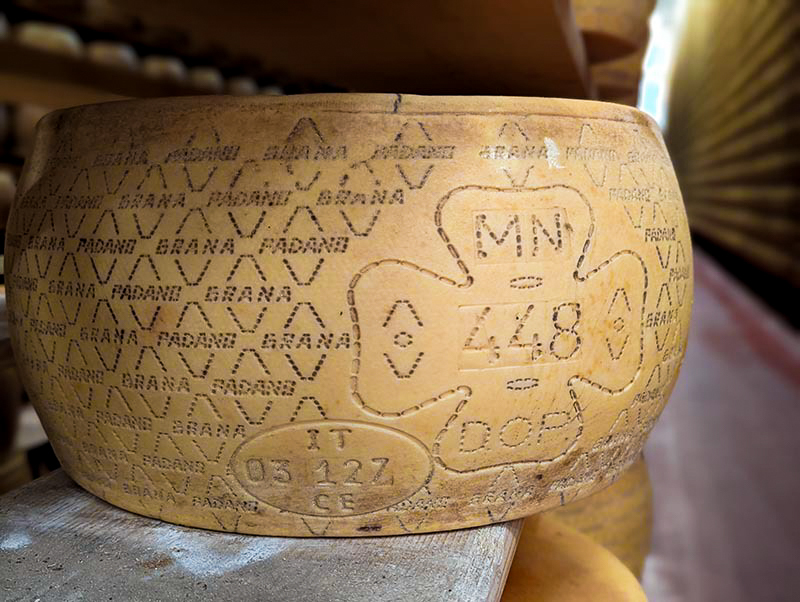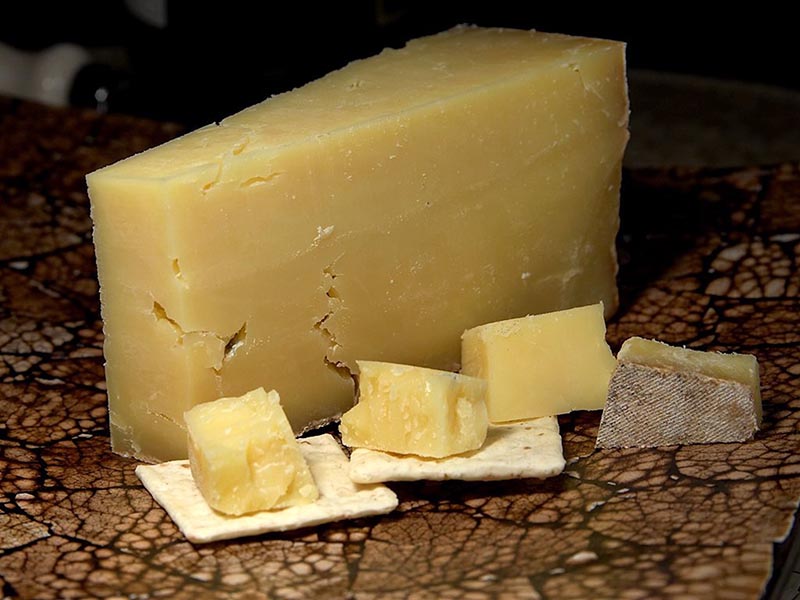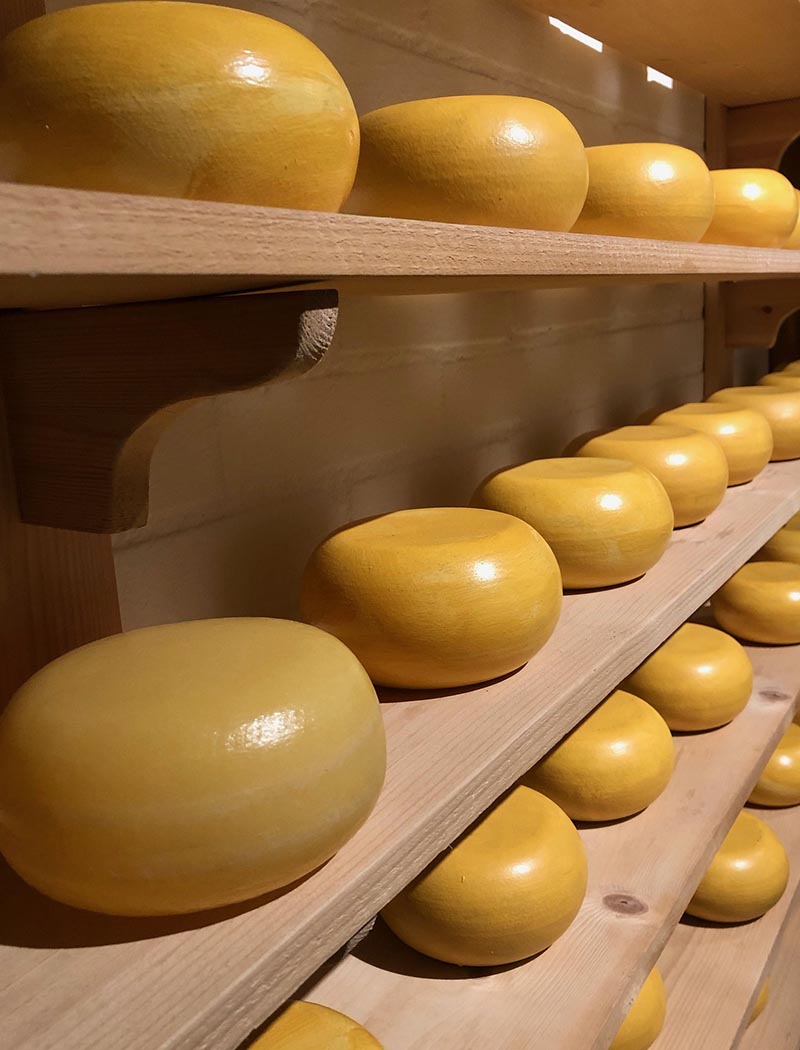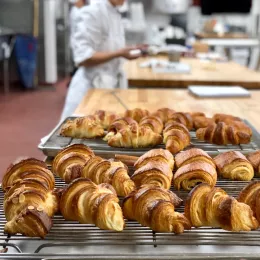Cheese is typically categorized by how different varieties are made, resulting in several major style distinctions. Depending on who is categorizing, this may result in many different styles.
Firm or hard cheeses are often grouped together for the sake of simplicity, and typically have a couple of major characteristics in common, even among diverse types of cheese.
First, most hard cheeses are typically “pressed curd” cheeses, meaning that curds are pressed to extract additional whey — the water component of milk — once they’re assembled into molds and before they begin the aging process. Second, firm cheeses are usually the result of at least several months of aging, which allows for even more moisture to evaporate out of the cheese, resulting in an increasingly firmer texture as more months are spent in the caves. The long aging process for firm cheeses can also help complex flavors develop.
Related reading: 5 Major Cheese Styles Every Chef Should Know
In exploring different subcategories within the catch-all hard cheese category, it’s not only helpful to understand how various hard cheeses differ in how they’re made, but also how they function in a culinary framework. Not all cheeses are built the same when it comes to what happens when heat is applied. Here, we explore different culinary uses of various hard or firm cheeses.

Grana Cheese
Meaning “grain” in Italian, grana cheeses are some of the most important cheeses worldwide when it comes to their culinary usage. Parmigiano-Reggiano and Grana Padano are the most famous cheeses in this category. Both must be aged for at least nine months — 12 in the case of Parmigiano-Reggiano — resulting in a dry, crumbly texture and a savory flavor. But age isn’t the only defining characteristic when it comes to these types of cheeses, and how they may be used in cooking.
There is a particular nuance in the cheesemaking process for these cheeses that accounts for their granular structure. In cheesemaking, rennet is used in order to coagulate cheese, turning liquid milk into a solid. After this step, curds are cut. In the case of grana cheeses, curds are cut into incredibly small bits, or grains, before being set into molds. This small granular structure contributes to the endgame of these kinds of cheeses, as they are perfect for grating. Think the flurries of cheese topping salads, instantly thickening soups and salad dressings or combining with hot noodles to create an immediate sauce. These cheeses have a more powdery structure when grated than other types of firm cheese, and the smaller the particles, the more easily they adhere to whatever you apply them to.
Read more: The Difference Between Parmigiano-Reggiano, Grana Padano and Pecorino

Cooked Curd Cheese
Welcome to your best melting cheeses — cooked curd cheeses — which have a tendency to ooze gracefully, whether or not they are incorporated with any other creamy ingredients. When heat is applied, cooked curd cheeses turn into a naturally emulsified pool of fondue due to a nuance in their cheesemaking process.
Sometimes classified as “pressed and cooked,” most in large format, Alpine or Alpine-style cheeses such as Gruyère, Comté, Emmenthaler, etc., fall into this category. During the making of these types of cheeses, curds are gently heated to between 118° and 132°F, knitting their protein and fat structure together in such a way that they stay cohesive when cooked in the future, and not becoming lumpy or separated. Many of the most famously cheesy dishes from around the world rely on this type of cheese, such as fondue, tartiflette and French onion soup. Not all cheeses are created equal, especially when it comes to meltability, and knowing which cheeses are cooked curd melters is important for professional and amateur cooks alike.
Read more: All About Alpine Cheese

Cheddar Cheese
Cheddar cheese is considered its own style of hard or firm cheese because of a particular distinction in its making process. “Cheddaring” has become a verb in a similar way as “Xeroxing,” using the name of the product to describe its process. In cheddar cheesemaking, curds are cut, stacked and re-cut and stacked, creating a Tetris-like structure in the resulting cheese. Real, aged English cheddars, or those which are bandaged or clothbound, get crumbly with age, and incredibly savory, oftentimes revealing notes of horseradish or mustard in their flavor.
This depth of flavor makes cheddar an excellent culinary cheese, however, its unique structure doesn’t provide the same kind of meltability as the cheeses described above. (Cheddar cheese is a pressed curd cheese, like all of the firm cheeses here, but is not a cooked curd cheese.) Because it can tend to leach its oil when heated, it is important to use cheddar in a milk-based, béchamel sauce, or to combine it with other melting cheeses in order to achieve a desirable consistency. Because of its robust flavor, however, cheddar also works well when baked into savory dough.
Read more: Understanding Cheddar

Gouda/Washed Curd Cheese
Similar to cheddar, gouda is also considered a unique category of cheese unto itself because of the process it undergoes during cheesemaking. After whey is separated from the curds in its early stages, gouda’s curds are rinsed with water to remove additional lactose. With less lactose available to convert to lactic acid during the aging process, gouda cheeses typically possess a more pronounced sweetness rather than savory or sharp characteristics. This “washed curd” approach, which also happens with heated water, also renders gouda a great melter. In Dutch culture, gouda is often used for snacking more than cooking, however, gouda has similar applications to other cooked curd cheeses above. Because of its inherent sweetness, gouda is often useful alongside milder flavors.
Read more: Understanding Gouda






